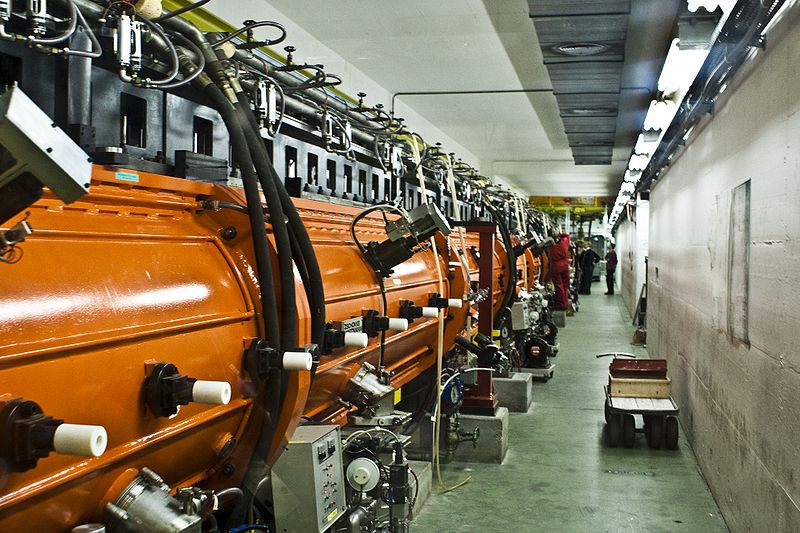Late last week, scientists from the European Council for Nuclear Research (CERN) in Switzerland recorded particles moving faster than the speed of light.
The particles, called neutrinos, were generated at the Super Proton Synchrotron particle accelerator at the CERN Large Hadron Collider Complex in Geneva. They were then accelerated to Italy, a distance of 732 km (approximately 455 miles), to the Gran Sasso National Laboratory and buried up to 11.4 km (a little over 7 miles) into the earth.

These neutrinos are neutral particles that have little to no mass and can pass through matter without being absorbed. Because of this, they are able to pass through the earth without their velocity changing. According to an article in WIRED, there are three different kinds of neutrinos: electron, tau and muon neutrinos. With this experiment, CERN intended to look at the possibility of muon neutrinos transforming into tau neutrinos during a phenomenon known as neutrino oscillation. Instead, they discovered neutrinos arriving at the Grand Sasso much faster than expected.
Researchers at the Oscillation Project with Emulsion-tRacking Apparatus (OPERA) in Italy recorded the time it took for 16,000 particles to travel from Geneva to Italy over three years. On average, as reported by an article in Science, the neutrinos arrived sixty nanoseconds sooner than if they’d been traveling at the speed of light.
According to Boston University Professor Andy Cohen, who specializes in cosmology, specifically relativity, anti-matter and dark matter, there are a few ways to interpret this result. The experiment could be right. If that’s true, it could usher in a new era of exploration of relativity physics, specifically Einstein’s theory of relativity. The theory of relativity allows comparisons between the dimensions of space and time, which normally cannot be compared in pre-relativity physics. It’s based on the idea of a universal maximum velocity, and that velocity is currently the speed of light. If something can travel faster than the speed of light, his theory is unfounded. The relationship between mass, energy and the speed of light, represented by the equation E=mc2, would be wrong. Nuclear weapons, radioactive dating and nuclear medicine are just a few examples of what would have to be reevaluated.
There could also be an unknown problem within the experiment, known as a systematic uncertainty, that was not taken into account. However, the measurements in this experiment are recorded as precisely as possible. Time is recorded with GPS timing signals. The signals take into account probability distribution functions that could affect the path of the neutrinos. The distance between the CERN LHC Complex and the Gran Sasso National Laboratory is known within 20 cm. The final option is the possibility of a completely overlooked systematic error, something unknown that CERN and OPERA aren’t aware of. Researchers brought their result to the public’s attention in order to fact-check, not to claim it as correct. The CERN press release addresses this, stating that “given the potential far-reaching consequences of such a result, independent measurements are needed before the effect can either be refuted or firmly established. This is why the OPERA collaboration has decided to open the result to broader scrutiny.” Relativity and the idea of a universal maximal velocity has been challenged before, as a Wall Street Journal article points out. This experiment needs to be investigated heavily before big claims can be made. Fermi National Laboratory in Chicago has already begun looking into CERN and OPERA’s claim.
Andy Cohen praises the press release for its discretion. He said in an email, “The OPERA experimenters are being appropriately cautious in presenting their results without making exaggerated claims. They have looked at their data carefully and have performed a careful analysis of the uncertainties involved. They are now encouraging other physicists, especially other neutrino experimenters, to examine the issue to either confirm or refute their interpretation of the data.” One result won’t change everything at once, and the affects of this experiment have yet to truly be determined.

Nothing in the Neutrinos-to-Gran Sasso experiment is buried 7 miles into the earth. The secant path from Geneva to Gran Sasso is 7 miles deep at its deepest point.
Neutrinos are NOT “accelerated” at CERN. They can’t be accelerated. They are produced instantaneously in collisions and are born moving at the speed of light.
There is a differnce in the meaning of “affects” and effects. One is a verb – the other a noun. You need the noun in your article.
Scientists can rerun the experiment and the results may go one way or the other. However, there is a way to see if the speed of light is constant or not; whether e=mc2 is right or not, and that is to go back to the original equations of special relativity and see what they teach from the basic lorentz equations and the derived e=mc2….
speed of light
e=mc2